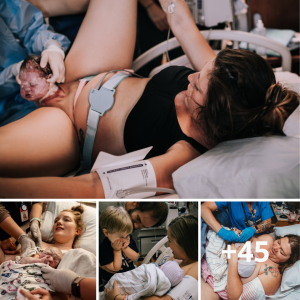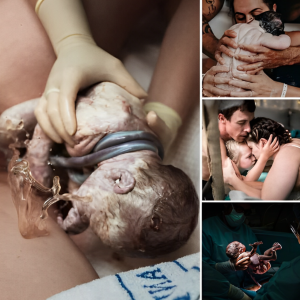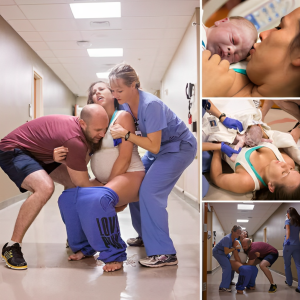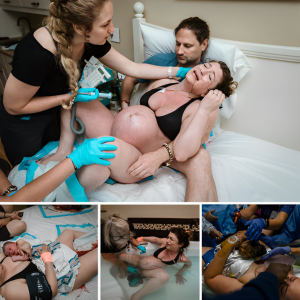After nine months, you know what to expect from pregnancy — but what about when you’re laboring and delivering? While every birth is different, a vaginal birth is the most common form of delivery.
Here’s what you can expect leading up to, during and after those hours of childbirth.
What is a vaginal birth?

A vaginal delivery is when a person gives birth through the vagina, usually between 37 and 42 weeks of pregnancy.[1] About 2 in 3 women deliver vaginally, whereas another 1 in 3 deliver via cesarean section (C-section): a surgical delivery of the baby through incisions in the abdomen and uterus.
A spontaneous vaginal birth occurs naturally, when you begin to have contractions on your own, whereas if you’re induced, you’re given certain medications that help prepare your cervix for labor.
Vaginal births tend to be the safest form of delivery for both mother and child.
How do you prepare for a vaginal birth?

While it’s impossible to plan for every aspect of your labor and delivery, it never hurts to be prepared. Here are a few things you can do:
- Create your birth plan, so you and your practitioner are on the same page as to how you’d ideally like your birth to go down (keeping in mind, of course, that things rarely go exactly as planned)
- Pack your hospital bag
- Make a visit to the hospital or birthing center where you want to deliver
- Take peek at a few common labor positions
- Read up on breastfeeding basics, since you’ll most likely be able to give it a shot the moment your baby arrives
- Know the signs of labor so you’ll be aware when baby’s almost here
The stages of a vaginal birth

For women who deliver vaginally, childbirth progresses in three stages:[2]
Read This Next
Inducing Labor: What Happens When You’re Induced?
Having a C-Section (Cesarean Section)
What Are the Stages of Labor and How Long Does Labor Last?
Stage 1: Labor
Labor itself is divided into three phases — early labor, active labor and transitional labor. All women who deliver vaginally will experience all three phases of labor, though you may not notice the first phase at all. The timing and intensity of contractions can help clue you in to which phase of labor you’re in, while periodic cervical exams will confirm your progress.
Stage 2: Pushing and delivery of the baby
This is when your cervix reaches the magic 10-centimeter mark — meaning you’re fully dilated. Now it’s your turn to push your baby the rest of the way through the birth canal, unless you’re laboring down (in which case you’ll catch a break for a few minutes to an hour while your uterus does most of the work bringing baby farther down into the birth canal).
You may wonder: Does pushing hurt more than contractions? Most women actually find that transitional labor, or those last 2 to 3 centimeters of dilation, is the most demanding and intense phase of labor — but it’s fortunately also the shortest, usually lasting 15 minutes to an hour. As your baby crowns, you’ll feel a tingling, stretching or burning sensation (it’s called the “ring of fire” for a reason).
Stage 3: Delivery of the placenta

The hardest part is over. In this final stage of labor, you’ll continue to have mild contractions as your practitioner helps you deliver your baby’s placenta. Your doctor will examine it as well as your uterus to be sure everything’s as expected.
Pain relief and medication during a vaginal birth
A vaginal birth doesn’t have to be a pain. A number of medications can manage your labor pain. These include:
- Stadol or Nubain
- Laughing gas (nitrous oxide)
- The epidural (2 in 3 women choose epidurals — and most find they are able to push very effectively with the help of their support person or birth coach)
Meeting your baby after a vaginal birth
As long as you haven’t experienced any complications during labor and delivery, you’ll be able to hold your baby — and breastfeed, if you choose — immediately following the birth, often while you’re delivering your placenta and your practitioner is repairing any tears.
Take the time for some quality snuggling together, and speak up, since your baby will recognize your voice and your partner’s. You may feel an immediate bond with your baby, or you may feel somewhat detached. Both responses are completely normal. No matter how you feel now, you will come to love your baby intensely.
How long does it take to heal after giving birth?
How fast your vagina will recover after birth varies based on a lot of factors. Healing generally takes about three to five weeks if you didn’t have any tearing, and about six weeks if you had perineal tears or an episiotomy.
What is the difference between a natural birth and a vaginal birth?
A natural birth is a vaginal birth that occurs without using medication. A vaginal birth, on the other hand, can include pain medications like laughing gas or an epidural.
Many women who choose to have a natural birth use alternative therapies to manage their labor pain, like acupuncture, hypnobirthing, water birth, reflexology and distraction.
While you can get all of these therapies and more by giving birth at a hospital, many low-risk moms hoping for a natural birth choose to deliver in a birthing center, where births are managed either without medication or just laughing gas.
Considering a home birth? Be aware of the risks and know that not every woman is a good candidate. And you should definitely have a physician or certified midwife present.
What if you need to be induced?
If you’ve reached 42 weeks, have a pregnancy complication that puts your life or your baby’s life at risk, or 24 hours have passed since your water broke and contractions haven’t started, you may need to be induced.
First, your doctor will look for signs of dilating and effacing — signs that your cervix is opening up for birth. If necessary, you may be given medications like prostaglandins or have a Foley balloon inserted to kickstart the process.
Often, that’s enough to bring on contractions, but if you don’t start having them on your own, your doctor may give you Pitocin, a synthetic version of the labor-inducing hormone oxytocin, to get them going. Once your contractions are in full swing, your labor should progress just like a non-induced labor.
Keep in mind that how your induction progresses can vary based on your pregnancy risk factors, so it is important to discuss any concerns about being induced with your health care provider.
What if you want a vaginal birth but need a C-section?
Even if you have your heart set on giving birth vaginally, 1 in 3 moms end up requiring a C-section. Your doctor might schedule one if:
- You have a chronic condition (like heart disease) that makes a vaginal delivery dangerous
- You have a pregnancy complication (like placental previa)
- You’re carrying a very large baby
- You’re carrying multiples
- Your baby is in a breech position
Even if you’re scheduled to give birth vaginally, your doctor may also perform an emergency C-section during the birth process if labor doesn’t start or stalls, if your baby is in fetal distress, if you have a prolapsed umbilical cord, or if you have uterine rupture.
Just remember: The best birth is always the one that’s the safest — and any delivery that finishes with a healthy baby in your arms is a success.
What is vaginal birth after C-section (VBAC)?
If you delivered by C-section the last time you gave birth, you’re probably wondering whether you’ll be able to have a vaginal birth after C-section (VBAC). In short: You may be able to, though a number of factors can increase or decrease your odds. Talk to your practitioner about what’s safest for you and your baby.
How long does it take to recover after a vaginal birth?
The first six weeks postpartum are considered a “recovery” period (you might also hear it referred to as your “fourth trimester”). For the first week postpartum, you’ll likely experience vaginal bleeding, cramps, exhaustion, perineal discomfort, difficulty urinating and having bowel movements, and all-over achiness, among other physical symptoms.
Emotionally, in the first weeks after birth you may have the baby blues or feel jittery, excited, overwhelmed or frustrated. Hang in there. Gradually over time, the symptoms will recede, you will start bonding with your baby, and you will feel like having sex again.
If, however, you’re experiencing symptoms of postpartum depression — including feelings of hopelessness, sleep problems, lost appetite, irritability, social withdrawal, excessive worry and aversion to your baby — talk to your practitioner. Getting the help you need is essential for both you and your baby.




